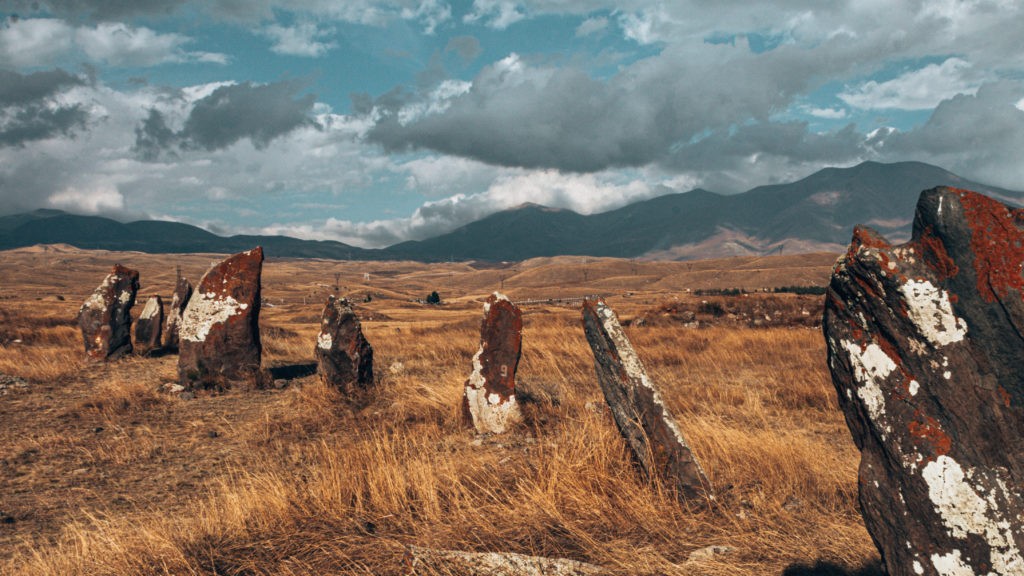Ancient Armenia (3500 BC - 520 BC)

Armenia is one of the oldest countries in the world with a recorded history of about 3500 years. The oldest known ancestors of modern Armenians, the Hayasa-Azzi tribes, also known as Proto-Armenians, were indigenous to the Armenian Highland in Eastern Anatolia. These tribes formed the Nairi tribal union, which existed until late 13th century BC. The legendary forefather of Armenians, Hayk, famous for his battles with Babylonian ruler Bel, most likely was one of the Hayasa tribal leaders. The words 'Nairi' and 'Nairian' are still used by Armenians as poetic synonyms of the words 'Armenia' and 'Armenian'.
At the end of the second millennium BC, another Indo-European ethnic group, closely related to Thracians and Phrygians and referred to by the Greeks as Armens, migrated to the Armenian Highland from Northern Balkans. According to a Greek myth, which actually reflects this tribal migration, the forefather of Armenians - Armenios - was one of the Argonauts, accompanying Jason in his quest for the Golden Fleece. In the year 1115 BC, king Tiglath Pileser I of Assyria reports a battle with a force of 20,000 Armens in the Gadmokh province of Assyria.
The mixture of Armens with the indigenous Hayasa eventually produced the Armenian people as it is known today. The existence of two major segments in the Armenian people is best of all illustrated by the fact that Armenians call themselves "Hay" and their country "Hayastan" after Hayasa, while other peoples call them Armenians and their country Armenia after the Armens. The Armenian language is basically the language of Armens, which is the only survivor of the now extinct Thraco-Phrygian group. It incorporated a large number of Hayasa words and grammatical features, as well as a significant number of non-Indo-European words from minor ethnic groups, which also took part in the ethnogenesis of Armenians.
The first significant state of the Armenian Highland was the highly advanced Kingdom of Ararat (with the capital in Tushpa, today's Van), better known under its Assyrian name Urartu (Ararat). This state was formed in the XI century BC and existed until VII century BC. Although populated mostly by Armenians, Urartu was ruled (at least during the first centuries) by a non-Armenian and non-Indo-European dynasty. In 782 BC the Urartian king Argishti I founded the fortified city of Erebuni, which is today's Yerevan, the capital of Armenia. Another major city in the Valley of Ararat was Argishti-khinili, also founded by Argishti I in the year 775 BC.
In the late VII century BC Urartu, weakened by Scythian invasions, fell, but after several decades was revived under the Armenian Yervanduni (the Orontides) dynasty with the capital in Armavir, former Argishti-khinili. The revived kingdom was already called Armenia by its neighbours, but in some languages the older name, Urartu, was still in use. In the famous tri-lingual Behistun inscription of Persian king Darius the Great (522-486) the same country is referred to as 'Armenia' in the Persian and Elamite versions, and 'Urartu' in the Akkadian version.
Artashisian dynasty, First Armenian Kingdom

Armenia under the Yervanduni dynasty soon became a satrapy of the mighty Achemenide Persia, and later part of the Seleucid Empire. It restored its full independence in 190 BC under the king Artashes I, founder of the Artashesian dynasty (the Artaxiads).
The kingdom started to expand and reached its peak during the reign of Tigran II, also called Tigran the Great (95-55 BC). Under Tigran, Armenia ascended to a pinnacle of power unique in its history and became the strongest state in Asia Minor. Extensive territories were taken from Parthia, which was compelled to sign a treaty of alliance. Iberia (Georgia), Caucasian Albania, and Atropatene had already accepted Tigran' suzerainty when the Syrians offered him their crown (83 BC). Tigran penetrated as far south as Ptolemais (modern Akko in Israel). As a result, the empire of Tigran II stretched from the Caspian Sea in the East to the Mediterranean Sea in West, and from Mesopotamia in the South to the river Kura in North. Political strengthening and territorial expansion of Armenia was accompanied also by unprecedented cultural development, with rich cultural heritage of Urartu intermixing with Hellenistic features. As a result Armenia during the Artashesian period became one of the most Hellenized and culturally advanced countries of Asia Minor.
After the death of Tigran II, Armenia was reduced back to its ethnic Armenian territory and found itself in the middle of a long war campaign between Rome and Persia, with each superpower trying to have Armenia as its ally, as the military assistance with Armenia was crucial for gaining political superiority in Asia Minor.
Arshakunian dynasty, Second Armenian Kingdom

In the middle of the I century AD a new royal dynasty - the Arshakuni (the Arsacids) - was established in Armenia. This dynasty was related to the royal family of Persia, which bared the same family name. At this period Armenia and Persia enjoyed a long period of peace and cooperation, until in 251 AD the Sassanid dynasty came to power in Persia. Regarding Armenia as the ally of the overthrown dynasty, the Sassanids adopted anti-Armenian policy, trying to eliminate the Armenian state and to assimilate the Armenian nation. Since the Armenian religion of that period bared similarities to both Zoroastrianism and Greco-Roman polytheism, in the realization of their anti-Armenian policy the Sassanids were trying to capitalize on the religious closeness. In order to deprive the Persians of this advantage, the Armenian king Trdat III in 301 AD declared Christianity the state religion of Armenia, thus making Armenia the first Christian state in the world, with Gregory the Illuminator as the first head (Catholicos) of the Armenian Apostolic Church. Christianity was officially legalized in the Roman Empire 12 years after Armenia became officially Christian.
Arab invasion and Byzantine Empire
By the end of the IV century the Byzantine Empire and Sassanid Persia officially established their spheres of influence in Armenia. The Arshakuni dynasty was dissolved in the year 428, and eastern part of Armenia was annexed to Persia, while the western part was put under Byzantine rule. The Sassanids were forcing Armenians to convert to Zoroastrianism, causing the Armenian revolt of 451 under the leadership of prince Vartan Mamikonian, commander-in-chief of the Armenian army. Although the Armenian forces, outnumbered by the Persians, actually lost the legendary battle of Avarayr, and Vartan Mamikonian himself was killed, this turned out to be a significant victory for Armenians, as Persians eventually gave up their efforts to convert and assimilate Armenians, and were forced to agree to much higher level of autonomy for Armenia.
The spiritual independence of Armenia was further asserted in 554, when the second Council of Dvin (capital of Armenia of that period) rejected the dyophysite formula of the Council of Chalcedon (451), a decisive step that cut Armenians off from the Roman and Greek churches as surely as they were already ideologically severed from the East.
By the time of Arab invasion in 634 Armenia, ruled by prince Theodore Rshtuni, was virtually independent. After conquering Persia, the Arabs started to concentrate their armies against Armenia, but didn't manage to conquer the country until 654.
Bagratunian dynasty, Third Armenian Kingdom

After more than two centuries of struggle with the Arab Caliphate, Armenia regained its independence in 886, and both the Caliphate and Constantinople recognized prince Ashot Bagratuni as the king of Armenia. During the rule of the Bagratuni dynasty Armenia reached its peak in political, social and cultural development. The capital of Armenia of that period, Ani, was a magnificent city, known as "a city of one thousand and one churches". The Armenian architecture of the Bagratuni period, especially the dome laying techniques, for which Armenian architects were notorious, significantly influenced the Byzantine and European architectural styles.
At the end of the 10th century the Byzantine Empire, although ruled by an imperial dynasty of Armenian origin, adopted a near-sighted policy of weakening Armenia and eventually annexed it in 1045, thus depriving itself of an effective shield against disastrous invasion of Turkic nomads from Central Asia.
Rubinian dynasty, Fourth Armenian Kingdom
Before the fall of the Bagratuni kingdom a number of Armenian princes managed to escape from Armenia and found refuge in Cilicia, a region at the north-eastern corner of the Mediterranean Sea, where Armenians were the majority of population. In 1080 their leader, prince Ruben, founded in Cilicia a new kingdom, which became known as Cilician Armenia, or Armenia Minor (Little Armenia). The new Armenian state established very close relations with European countries and played a very important role during the Crusades, providing the Christian armies a safe heaven and provision on their way towards Jerusalem. Intermarriage with European crusading families was common, and European religious, political, and cultural influence was strong. The royal court of Cilicia and the kingdom itself were reformed on Western models, and many French terms entered the Armenian language. Cilician Armenia also played an important role in the trade of the Venetians and Genoese with the East.
Enduring constant attacks by the Turks, Mongols, Egyptians and Byzantines, Cilician Armenia survived for three centuries and fell to Egyptian Mameluks in 1375. The last Armenian king of Cilicia, Levon VI Lousinian, emigrated to France, where his grave still can be seen in the St. Denis Cathedral of Paris. The title "King of Armenia" passed to the kings of Cyprus, thence to the Venetians, and was later claimed by the house of Savoy.
Armenia under turkish rule
After the fall of the Cilician Armenia, the historical Armenian homeland, or Greater Armenia, was subject to various Muslim warlords, and eventually was divided between the Ottoman Empire (Western Armenia) and Persia (Eastern Armenia). Several Armenian principalities managed to preserve their independence or autonomy. The most significant among those was the Federation of Khamsa in Artsakh (today's Nagorno-Karabakh), which consisted of five allied principalities. De facto independent Armenian principalities existed also in the regions of Sasun and Zeytun in Western Armenia.
Being for centuries at the edge of physical annihilation, Armenians nevertheless managed to preserve and develop their national, religious and cultural identity. Apart from architecture, Armenians successfully manifested themselves in literature, painting, sculpture and music. Armenians were the 10th nation in the world to put their language in print.
Armenian Question
In 1828 the Russian Empire captured Eastern Armenia from Persia. Contact with liberal thought in Russia and Western Europe was a factor in the Armenian cultural renaissance of the 19th century. In the Ottoman Empire, the Armenians initially benefited with the rest of the population from the measures of reform known as the Tanzimat, and in 1863 a special Armenian constitution was recognized by the Ottoman government. These liberties were however unknown outside Constantinople, and the condition of Armenians in Anatolia was unbearable. A so-called "Armenia Question" emerged in the relations between the Ottoman Empire - "the sick man of Europe" - and European superpowers. After the Russo-Turkish War of 1877-78, in which Eastern Armenians had taken part, Russia insisted in the Treaty of San Stefano that reforms be carried out among the sultan's Armenian subjects and that their protection against the Kurds be guaranteed. This demand was softened at the Congress of Berlin, but the "Armenian Question" remained a factor in international politics, with Great Britain taking on the role of Turkey's protector until the end of the century.
Having lost most of its territory in the Balkans, the Ottoman Empire was afraid of losing Western Armenia as well, which would mean the end of the Ottoman dream of creating a pan-Turkic empire, stretching from Balkans to the Yellow Sea. A new state policy was formed, aiming at the final resolution of the "Armenian Question" through total annihilation of Armenians in their historic homeland of 3500 years. During the reign of sultan Abdulhamid Armenian massacres became a common phenomenon. In 1895, after Abdulhamid had felt compelled to promise Britain, France, and Russia that he would carry out reforms, large-scale systematic massacres took place in the Armenian provinces. In 1896 more massacres broke out in the capital and in Cilicia.
Having lost most of its territory in the Balkans, the Ottoman Empire was afraid of losing Western Armenia as well, which would mean the end of the Ottoman dream of creating a pan-Turkic empire, stretching from Balkans to the Yellow Sea. A new state policy was formed, aiming at the final resolution of the "Armenian Question" through total annihilation of Armenians in their historic homeland of 3500 years. During the reign of sultan Abdulhamid Armenian massacres became a common phenomenon. In 1895, after Abdulhamid had felt compelled to promise Britain, France, and Russia that he would carry out reforms, large-scale systematic massacres took place in the Armenian provinces. In 1896 more massacres broke out in the capital and in Cilicia.
Armenian Genocide

After coming to power in Constantinople, the Young Turks made the policy of "No Armenians - no Armenian Question" their main priority. Taking advantage of the favourable political conditions created by the World War I, they began the "final resolution of the Armenian question" on April 24th, 1915, by executing hundreds of Armenian intellectuals of Constantinople without trial. In Armenian provinces of Eastern Anatolia all Armenian males aged 15-62 have been conscripted, disarmed and executed. Defenceless Armenian women, children and the elderly were deported to the Syrian desert Der-el-Zor; most of them were brutally murdered on the way by Turkish soldiers or Kurdish nomads, or died of starvation and exhaustion. More than one and half million Armenians, i.e. 80% of the Armenian population of Western Armenia, perished in this first Genocide of the twentieth century. Several hundred thousand survivors of the Genocide found refuge in neighbouring counties, laying the foundation of the worldwide Armenian Diaspora. By the year 1923 Western Armenia was completely de-Armenized, and successfully incorporated into the newly formed Turkish Republic.
Nagorno-Karabakh movement
The 71 years of Soviet rule in Armenia were a period of relative security, of great economic development, and of cultural and educational achievements. But during the same period the government of Soviet Azerbaijan was conducting a systematic policy of removing the Armenians from Nakhidjevan, which today has no Armenian population whatsoever. The same policy was less effective in Nagorno-Karabakh, where Armenians remained the overwhelming majority. In February 1988 a peaceful, democratic movement for the reunification with Armenia began in Nagorno-Karabakh, and the regional Assembly of the Nagorno-Karabakh Autonomous Region adopted a resolution seeking transfer of Karabakh from Azerbaijan to Armenia, as a realization of the right of the peoples under alien domination to self-determination. The Azeri side responded by Armenian massacres in the Azeri cities of Sumgait, Kirovabad and Baku, transforming the peaceful movement into a violent conflict, and lately committing an act of military aggression against the Armenian population of Nagorno-Karabakh. The newly proclaimed Republic of Nagorno-Karabakh managed to defeat the invading Azeri forces and to create a security zone around its territory and a humanitarian corridor to Armenia. The negotiations on the future status of Nagorno-Karabakh are being conducted within the Organization for Security and Cooperation in Europe, through so-called Minsk Group, co-chaired by USA, Russian Federation and France
Restoration of Independent Armenia

Armenia restored its full independence on September 21, 1991, and became a member of the United Nations on March 2, 1992. On January 25, 2001, Armenia also became a member of the Council of Europe.












